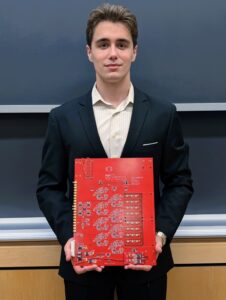Never underestimate how far you can go in only a year at Penn. One needs to look no further than Max Malakhovets for proof.
“Over the past few months here at Penn, I’ve been building a novel data acquisition board (DAQ) to support a first-of-its-kind analog photon processor (APP) chip,” Malakhovets said. His internship is part of a collaboration between the Penn nuclear and particle physics team (Josh Klein, Principal Investigator) and Lawrence Berkeley Lab. In this capacity, Malakhovets is part of a 20-engineer group and works under the supervision of Adrian Nikolica, an electronics engineer staff member and ESE PhD candidate in Professor Troy Olsson’s Lab. When complete, the APP system will be used at some of the world’s most advanced research facilities focused on particle physics.

To understand the importance of this project, let’s take a step back and review the potential practical use of this APP chip and how it can contribute to the advancement of Neutrino Detectors and Medical Technologies. “This chip is designed to process photon interactions, as it takes small electrical signals generated by photomultiplier tubes (PMTs),” Malakhovets said. Notably, PMTs are used broadly in medical PET scanners. “These processing chips, as applied to the study of matter and anti-matter, could potentially also be used in medical devices through a similar application of the APP Chip,” Malakhovets added.
The APPs chip’s ability to only process the most important real-time measurements increases efficiency and accuracy. Current systems, Malakhovets explained, generate massive amounts of data from thousands of PMTs. This makes it difficult to sift through, use and store the data, a current problem for modern detectors with thousands of photo tubes.
The DAQ board that Malakhovets designs will play a pivotal role in data processing. The APP outputs an analog signal, Malakhovet said, explaining that the DAQ board converts it into a digital signal. This digital signal then interfaces with a Field-Programmable Gate Array (FPGA) on a Systems-on-a-Chip-Board for “further processing and readout,” Malakhovets added, noting that both him and Nikolica are also working on the firmware logic for the FPGA.
The rising EE Sophomore expresses “immense gratitude” at having an opportunity to work on a project “typically reserved for graduate students.” That said, Malakhovets admits that the past few months have involved a “very steep learning curve.” Steep learning curve notwithstanding, Malakhovets discussed the DAQ Board’s design with enthusiasm: “It requires a precise, low-noise timing system, as noise greatly impacts precision with real-time data.” The board is currently in the “layout process which involves stacking components and ensuring controlled signals for low noise, likely resulting in a high-layer board.” It features a complex multiplexing system. According to Malakhovets, this allows the board to process multiple APPs. To ensure accuracy, the design will undergo ”a rigorous review,” Malakhovets explained, adding, “the designs are checked in-depth and defended, ensuring fundamental understanding and preventing costly errors.”
Malakhovets’ grandfather, also an electrical engineer, served as his primary inspiration when determining his educational path. Where it leads remains to be seen, but pursuing Master’s at Penn and perhaps working toward a doctorate remain in the mix. For extracurricular activities, Max is a member of Penn’s Varsity Swim Team. He qualified for last year’s Ivy League Championship and even medaled in the 200 Fly event.
While the total project will not be complete by the end of the summer, Malakhovet’s portion should be. Following that, he plans to take a break, first visiting his family in Canada, then backpacking through Italy and Germany with his mother. There, they plan to stay in hostels, go on adventures, and cook as many local dishes as possible. “We’ve used some creative methods to cook before,” Malakhovets said, laughing. “Once we used a coffee cezve to cook mushroom pasta. And believe me, it was amazing.”
